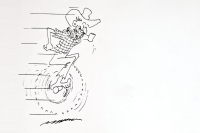The first lady of the South
First Lady of the Confederacy: Varina Davis’s Civil War by Joan E. Cashin. Belknap Press, 2006.
Civil wars are marked by a bitterness and a bloodlust that go beyond their conventional counterparts. The vicious fighting in Iraq serves as only one more example of the brutality of such a war. The English Civil War, the twentieth century wars between Communists and their opposition in Russia, China, and Vietnam, the Spanish Civil War: all illustrate the terrible carnage derived when citizens from the same country fight among themselves.
Our own Civil War was no exception. The harsh attacks by extremists in newspapers and speeches before the War carried over into the fighting, particularly after the summer of 1863 with the incursions into the Deep South and the invasion of Georgia by Sherman’s troops. The animosity on the Southern side only increased after the War, when that region remained not only impoverished — there was no Marshall Plan for the South — but was in many places occupied by Northern troops. For the next hundred years, issues of race, sectionalism, and poverty kept the South separated from the rest of the nation.
Joan E. Cashin’s First Lady of the Confederacy: Varina Davis’s Civil War (ISBN 0674022947, $29.95) gives us the American Civil War and its aftermath through the eyes of a woman, the wife of the president of the Confederacy. Though its premier purpose is of course to examine the life of Varina Davis, Cashin, an associate professor of history at Ohio State University, treats as well the devastating effects of civil war on the people and land of the South.
As Cashin so ably informs us, Varina Davis was born in Mississippi, but received much of her education in Philadelphia. After marrying Jefferson Davis, she did serve as mistress of his plantation, helping to oversee the care of the house and of the slaves, but she was happiest when they moved to Washington, D. C., where Davis served as Franklin Pierce’s Secretary of War and as a U.S. Senator. When war came in the next decade, she seemed as devastated by the fact that she had to leave Washington and return South as by the sectional conflict itself.
Related Items
Varina Davis, like her counterpart Mary Todd Lincoln, was never comfortable in her role as First Lady. She maintained a correspondence with several of her Northern friends, a source of friction with her husband and of suspicion in regard to her loyalties among other Confederates; she missed Washington’s social life; she found herself snubbed for various offences by some of the Richmond ladies. Her greatest trial during this time came 1864, when her five-year-old son fell from a balcony of their Richmond residence and died.
Following the war, Varina Davis suffered from other deaths of family members, from the stress of a brief imprisonment, from the poverty of her family, from moving homes many times, and from Southern criticism after the death of her husband, when she moved to New York, where she died in 1906.
Cashin, who finds much to admire in Varina Davis, writes that “she was forgotten in large part because she did not conform to the stereotypes of her own time or our own.” This statement contradicts the fact that people who tend to live as stereotypes, if such people do indeed exist, are rarely remembered by anyone. It is more likely that Varina Davis is little remembered today because she was a petty, indecisive woman who ruined her daughter’s engagement from selfish reasons, who wrote a memoir filled with inconsistencies and in some cases lies, who responded to Mississippians calling for her return to the South from New York with a letter, released by her own orders only after her death, that viciously attacked them.
Some of the reviewers of Cahin’s biography find in Varina Davis, as one of them says, “a twentieth-century woman out of her time,” thereby implying that she was somehow more “liberated” than other women around her. This is absurd. Cashin herself depicts Varina Davis and the women around her as belonging to a class that allowed them tremendous freedom. Davis, like hundreds of other women at this point in time, earned part of her living by writing books and articles. Her New York circle of female friends traveled widely, sent their daughters to colleges, transacted business, and began fighting for suffrage. To look upon an Irish washerwoman in a Brooklyn slum as oppressed is one thing; to look upon Varina Davis as oppressed is laughable.
It is, as I say, the reviewers and not Cashin who advocate this position. Her own work, particularly the post-Civil War history, offers us valuable insight into Varina Davis and into many Southerners who must have felt equally torn by their loyalties to their region and to their national government. Here she writes of Davis’s friendship with “another famous widow, Julia Dent Grant,” begun in 1893 at Cranston‘s Hotel on the Hudson River:
Over the next few days they met several times, taking an afternoon drive together and talking amiably on the hotel veranda. No one knows exactly what they discussed, but the sight of these widows having a friendly chat thrilled the other guests...Afterward, Grant said that Mrs. Davis was a bit stout but a “noble looking lady.” She already liked Davis, she told a reporter, and she hoped that they would become friends.
Julia Grant and Varina Davis maintained their public friendship and corresponded frequently into the twentieth century. Reading Cashin’s eminently enjoyable account of this friendship and other details from Davis‘s long life, we realize once again how diverse is the reality that dwells behind the façade of history as we know it.









